Guides
ON PLANTING

GROWING HARDY WATER LILIES
Little changed from the Early Cretaceous period, 125 million years ago, water lilies grow from rhizomes, much like iris, but unlike iris they are rooted in the bottom of shallow ponds, lakes and slow-moving rivers. Hardy water lilies will grow anywhere in Europe, and will survive winters even in northern Canada.
Beyond aesthetics, the other important criterion to consider when choosing a water lily variety is the depth of the pond. The planting depth is the distance between the mud in which the lily is planted, be it in a pot or on the pond bottom, and the surface. We have classified our water lilies into 5 size categories that correspond to depth.
Planting depth per size (depth is determined from top of the soil to top of the water):
- Mini: 10 to 25 cm
- Small: 20 to 40 cm
- Medium: 20 to 70 cm
- Large: 40 to 100 cm
- Extra large: 40 to 120 cm
Large lilies should be planted at a depth of 40 to 100 cm; medium lilies at a depth of 20 to 60 cm, and small lilies at a depth of 20 to 40 cm. Lilies classified as very small or very large may be planted in as little as 10 cm or as much as 1.5 m of water, respectively. If your pond is very deep, or too deep for a small or medium lily, you can easily raise the level of the planting container using bricks or cinderblocks.
Planting Water Lilies
In Europe, hardy water lilies may be planted from March through November, and they will flower off and on from May through October.
1) Choose the right spot : water lilies need full sun. A minimum of 6 to 7 hours a day of sun will ensure that your lilies flower to their full potential. Don't forget to take into account the surrounding vegetation so that colours and bloom times are complementary.
2) Choose the ideal planting container and earth : In our exhibition ponds we use 14L black, round planting containers with no holes. These are made to our specifications and are available for sale through this website. There is nothing wrong with using the perforated "aquatic planting" containers found in garden centres, but they offer no special advantages to the plants and they make division difficult (and they usually break during division). We've found that 14L pots hold about as much material as one person can safely manipulate. The ideal soil to use is a simple clay-rich topsoil. Avoid compost and other light planting mixtures.
3) Planting water lilies: The rhizome should be planted more or less horizontally, such that the stems are at a 90 degree angle with the soil. The crown of the rhizome, the point where the leaves and stems protrude, should remain at or near the surface of the soil. Make sure to water down the pot before submerging it to eliminate air bubbles. Insert three fertilizer tablets a finger-length into the soil in a triangle around the rhizome.
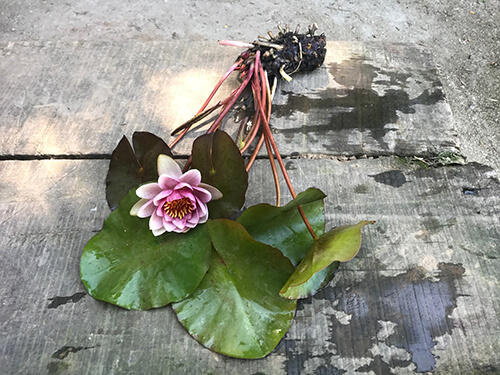
STEP 1: Take the water lily out of its bag.
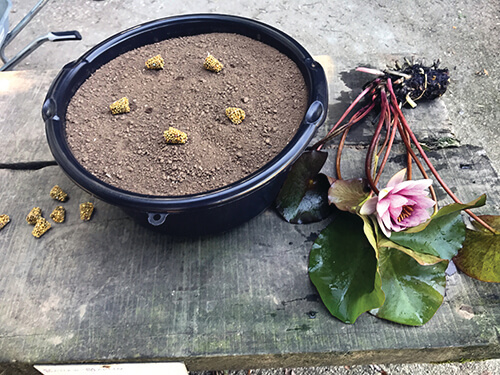
STEP 2: Fill a 14 to 20L pot with topsoil. Garden soil will suffice if it is rather heavy. A clay-rich or sandy soil is acceptable, but avoid a light soil rich in organic material (potting soil, peat, compost, manure, etc.).
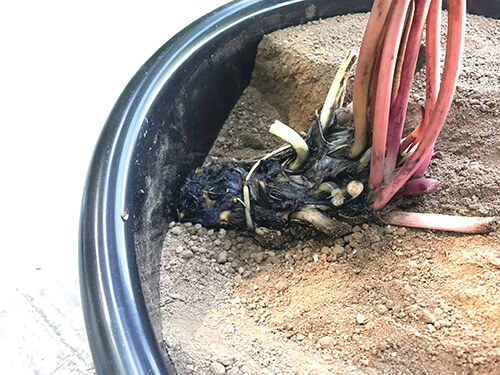
STEP 3: Create a small trench and position the rhizome well in it, with the cut part of the rhizome against the edge and the crown facing up and towards the center of the pot.
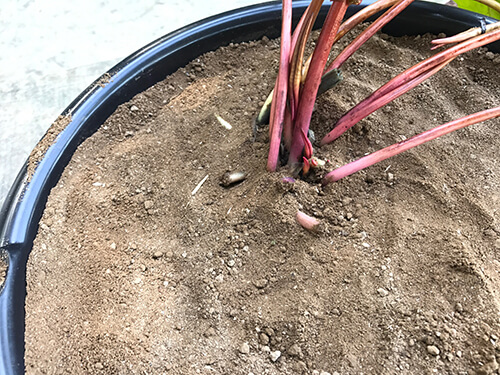
STEP 4: Cover the rhizome and tamp down the soil. The crown should be almost at the surface and the other side of the rhizome well sunk into the soil.
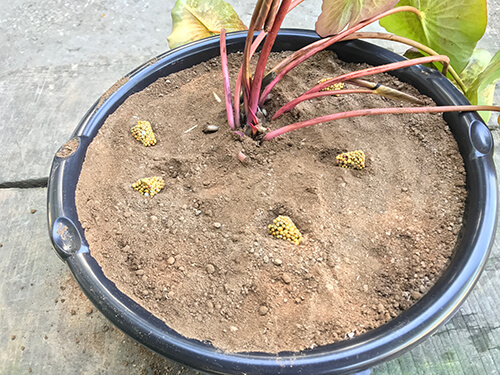
STEP 5: Position four or five fertilizer tablets around, and rather in front of, the rhizome.
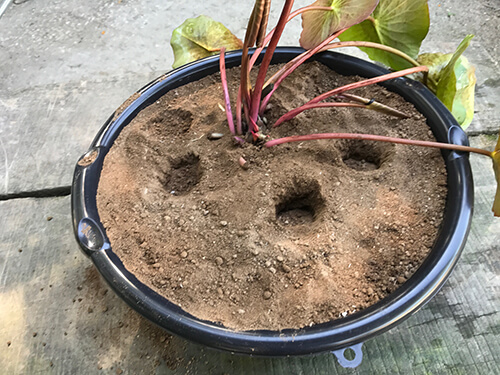
STEP 6: Press each tablet into the soil with your finger.
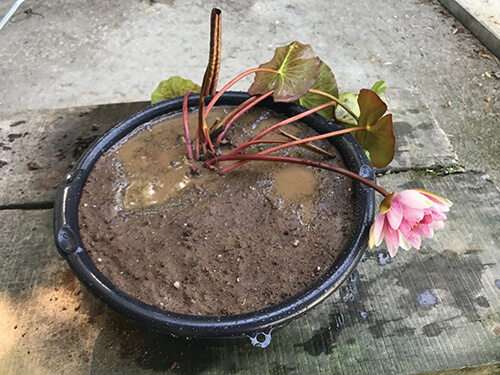
STEP 7: Important! Water the pot before submerging it in the pond to get the air out of the soil, otherwise the air bubbles can cause the rhizome to float out of the pot during installation.
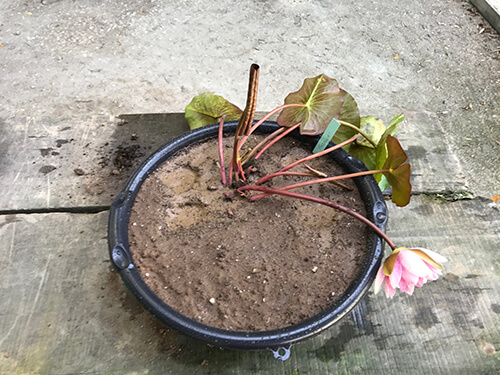
STEP 8: Once watered, push a label into the pot, so as not to forget the variety of water lily planted, and immerse it to the appropriate depth.
Caring for Water Lilies
In order to maintain your water lilies you will need to fertilize them once a year (if they are planted in containers) and divide them every three years. Neglect in either of these areas can lead to diminution of leaf size and a lack of flowers, and in the worst case the death of the water lily from overcrowding.
Fertilizing : We recommend using a chemical fertilizer in tablet form. Organic fertilizers can in some cases exacerbate certain diseases. The tablet form allows you to insert the fertilizer into the soil, where it will not diffuse into the pondwater. We use and sell a nitrogen-rich formula of Osmocote in tablet form. These have the advantage of being slow-release (application once per year), whereas the tablets marketed as specifically for aquatic plants need to be reapplied every 4 to 8 weeks.
Dividing : Every three or four years you will need to remove the lilies from their planting container and divide them so that they don't choke each other out. Dividing lilies requires some work, but it's not complicated. Isolate and remove the rhizomes. Keep any healthy rhizome that has a crown pushing leaves and buds. Cut away excess rhizome, leaving 6-8 cm of rhizome behind the crown. Replant these in fresh soil. The best time to divide is in April or September, but it can be done at almost any time.
Water Lily Troubleshooting
- Fungus-based Diseases: Brown or red spots on the pads usually indicate the presence of Ramularia nymphaearum. Affected leaves should be removed, and the remaining leaves should be treated with a fungicide. This disease is not fatal, but it should be treated as it is unsightly and can act as a gateway for more serious problems.
- Crown rot, caused by Phytopthora, is the most serious disease to afflict a water lily. Symptoms include a uniform and premature yellowing of the leaves, which then detach from the rhizome. On close inspection, the rhizome will smell like sour milk. If the disease is not treated, the principal rhizome will die. Powerful antifungal products exist today that will clear phytopthora while reinforcing the plant's immune system to prevent subsequent infections. Manufacturer instructions should be followed closely.
For an organic approach, we recommend treating the problem with domomite, or dolomitic lime. Fungal infections are usually the result of an excessively acidic pond and plants that lack nutrients. Dolomite will lower the PH and provide essential minerals.
Insects
- The black water lily aphid (Rhopalosiphum nymphaeae) can be a nuisance beginning in early summer, and it will attack other aquatic plants as well. Aphids pierce the leaves and stems of plants in order to eat the sap. If left untreated they will cause leaves to yellow and can render the lily vulnerable to other infections. Aphids can be drowned by dousing the lilies with the garden hose, or by spritzing them them with any viscous mixture, such as water and liquid soap. There are also a number of effective treatments available at your local garden centre.
- The China Mark Moth (Nymphula nymphaeata) is easily recognizable because the caterpillars will cut out pieces of the pad in order to make their cocoons.
- The water lily leaf beetle (Galerucella nymphaeae) is 5 mm in size and black in colour. It carves unsightly trails over the lily pads.
Both the china mark and the leaf beetle can be effectively treated with products containing the bacterium Bacillus thuringiensis. The bacteria disrupt the insects' digestive sytems,causing death within a few days. It is sold at most garden centres under various brand names.
Other pests include Coypu (Myocastor coypus), which are aquatic rat-like creatures the size of small dogs. Coypu were introduced to Europe from South America, and they need to eat 25% of their body weight per day in aquatic plants in order to survive. They pose a problem mainly for those with natural ponds and waterways. Crayfish can also harm water lilies, as can turtles and certain kinds of plant-eating carp.

Tropical Water Lilies
Tropical water lilies flower from May through October in most of Europe. They should be planted in 20 to 40 cm of water for best effect, though most can be planted as deep as one metre. The water temperature should be at 21 degrees celsius when planting occurs. Follow planting instructions for hardy water lilies. Tropicals are very heavy feeders and respond well to fertilizer. Use two to three times as much fertilizer as you would for a hardy water lily. The same principles apply to night-bloomers and day-bloomers.
Overwintering Tropical Water Lilies
In the most southern parts of Spain, Portugal, Italy and Greece, tropicals will go dormant during the winter and will normally come up again in spring when water temperatures reach 21 degrees celsius.
Everywhere else, tropicals will need to be brought indoors. There are a number of techniques for overwintering, below is the one we use at Latour-Marliac:
1) Let the lilies die back significantly from the cold, , or remove them from the water and let them dry out. This forces the plant produce corms or bulbs.
2) When this has occurred, usually sometime in November or early December in Europe, remove the plants and check for corms. Corms, which are similar to bulbs, will form around the base of the plants, and can be as large as tennis balls, or as small as marbles. Discard the parent plants.
3) Rinse the corms well in tap water, removing all mud and old roots.
4) Treat them with a mild fungicide, like sulphur.
5) Place them in small plastic bags or containers filled with damp sand or sphagnum moss.The sand or moss should be damp, not wet.
6) Place these out of direct sunlight in a room heated to 18-20 degrees celsius.
7) In spring, replant the lilies when the water temperature reaches 21 degrees celsius.
8) OR, to get a head start 4 to 8 weeks before outdoor planting time: plant the tubers in small pots (like yogurt containers) and place them in a heated aquarium in a sunny window.
9) Once they start growing, push a fertilizer tablet into the soil.
10) When it's warm enough outside, remove the root balls from the little pots and transfer them to the larger outdoor pots.
